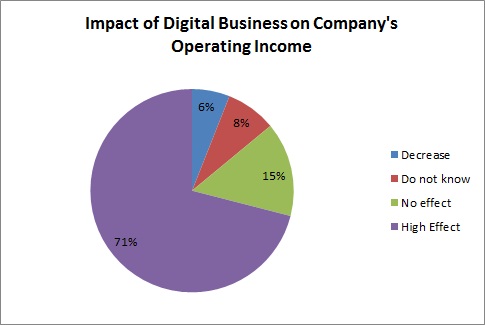The Path to Analytics & Digital Adoption: Strategic Perspectives
3AI October 26, 2020

The Optimism around Digital and Analytics
The prospect of adopting Digital and Analytics has a very high approval among most of the top companies and executives. According to a Gartner Survey, by 2016, around 50% of businesses intend to go significantly digital, and that number is anticipated to go till 83% by 2019. Businesses are focusing on three key areas – Big Data & Analytics, Digital Marketing & Social Media and Mobility Solutions & Cloud Integration – the first one covering the prospects of Analytics solutions while the rest two being part of creating a Digital enterprise. Of the three, the first two are getting major focus of implementation across companies; with more than 50% of the company executives claiming that they have made it one of their top 10 priorities as far as Key Corporate Strategies are concerned. They believe its implementation will result in increasing their operating income by more than 11%. Almost three fourths believe that the implementation will have a considerable impact the business in a positive way.
The effects are quite evident, even in the organization structure. There has been a significant change in the leadership position of the CIOs. Business Executives are now being driven to know a substantial amount about Digital & Analytics, and rely on the CIOs to lead. Even in the board of directors, more than half of them are being directly associated with digital business initiatives.
Around 50% of the companies perceive these digital business trends as part of an offensive strategy, which includes leveraging this technology to build a more refined competitive advantage, or using the trend data to design a new product, service or solution as part of looking to tap into new profit pools. As far as competitive advantage is concerned, instead of people and their viewpoint being the authority to represent things, the things are the authority for viewpoints now. What information would be strategically important for the business to attain competitive advantage or going for a blue ocean strategy, is now decided by data analysis. This helps gain insights, which was previous inconspicuous, that will help create new industries and capture new markets. Intricate data insights, and not strategic thinkers, are the new visionaries.
The Gap in adoption
With all the promise that Digital and Analytics seem to bring to enterprise, it is quite surprising to find that its implementation is still in its infancy. Almost 50% of the respondents say their companies’ investments in digital initiatives are too small to achieve their strategic goals. As far as Big Data is concerned, half of the companies are focusing their efforts on customer insights, segmentation, and targeting to improve overall performance, even more say that adoption of data and analytics to generate insights, but when it comes to actual implementation, less than 20% have fully deployed Data and Analytics as a core function to generate insights, for one business Unit. The number goes even lesser (13%) for the number of players who have deployed across multiple business units, or all of them.
“Around 70% of companies believe Digital & Analytics is the way forward, yet around 50% say implementation is too small”
For most of the companies, adoption of Digital Marketing & Social Media techniques are mainly focused on positioning, branding and customer engagement initiatives while the adoption of other practices is at most modest.
The numbers are even modest for Mobility Solutions & Cloud Integration. The implementation for those are limited to a foundation layer for almost all of the companies, which focuses on the very basic functions in these areas, such as implementing only the core functions as part of mobility solution or keeping only the critical processes under cloud. Even for the basic implementation of Mobility solutions, only 45% of them claim they have at least a minimum setup, for cloud it’s only around one-third.
Reasons for Shortcomings
Despite all the optimism surrounding Digital and Analytics, executives point to certain challenges in bridging the gap between envisioning the scope of these technologies and implementing them. Some of the major challenges are described below:
Shortcomings in infrastructure and IT systems are the major reasons because of which companies lack the potential in scaling up their IT capabilities. A typical IT system implementation is usually too ill-equipped to process insights from the data-rich environment. This calls for some high-input investments. Companies need to secure around 3% of their total cost base for investing in digital business initiatives; with the CFOs and CIOs claiming even more might be required.
Having the right Organization Structure is also one the challenges faced currently by enterprise. Finding good resources to help develop in-house capabilities in Digital and Analytics is quite challenging. Add to that further competition, not only in their industry verticals, but also from startups and tech enablers, coming up with disruptive solutions in this already dynamic and ever-changing avenue. Companies need to secure the right amount of resources with the right perquisites, which again requires revisiting the budget.
Overall organizational shortcomings are also one challenge cited by most of the executives. Implementing Digital and Analytics capabilities calls for a completely different operating paradigm which requires free flow of information among different unit. The existing setup comprising of siloed functions (IT, marketing, product research etc.) becomes an obstruction to a dynamic approach to digital business that requires seamlessly networked architecture with speed and flexibility to create the most value.
Addressing the Challenges
While their companies’ current implementation of digital and analytics technologies point to substantial room for growth, executives are majorly optimistic about its future implications. But to create an all-encompassing, efficient, metrics-directed system of digital and analytics in the future requires taking steps at the present.
CIOs have to shoulder a lot of responsibility to create a tech-enabled digital and analytics ecosystem, to meet the business transformational challenges. This becomes possible when they understand the business as a whole. The CIO and his team needs to be responsible for actively creating promoting the need to implementing digital as a core objective, backed by data-driven returns to the company. This needs to be done not only to the management or the board of directors, but also to the whole of organization structure, to attract proper investments. Companies where the CIO plays a more active role gets to implement the digital and analytics enabled ecosystem quicker.
Also a new approach to talent management by incorporating flexible and dynamic team structures and partnering with outside collaborators is required. Companies should be resourcefully focused on developing homegrown skills wherever possible.
The positive aura surrounding the application of Digital and Analytics doesn’t seem to remain as an aura for long. The gap seems to be because of the requirement of a completely different business operating paradigm, which is slow in implementation, but sure.






